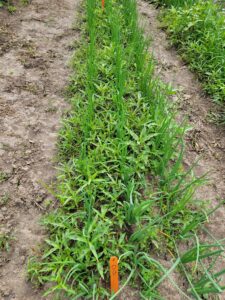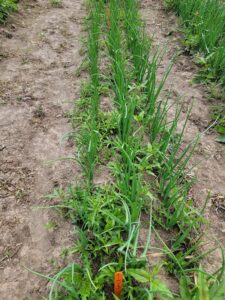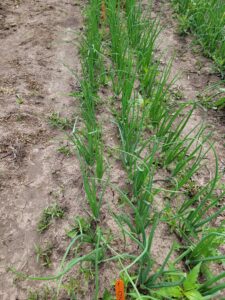Collaborators: Horticulture Crops Weed Science Lab and Purdue University Student Farm
Problem Statement: Small farm operators are hesitant to use herbicides, citing concerns of crop injury and carryover. Additionally, small farm operators often do not have the acreage required to justify using many different herbicides. Often these farmers resort to hand-weeding, especially in small-seeded or shallowly rooted crops, such as onion. S-metolachlor (Dual Magnum) is a herbicide with a broad label in Indiana and has limited carryover potential.
Materials and Methods: Field trials were conducted at the Purdue University Student Farm, West Lafayette, IN, to determine if single and sequential applications of S-metolachlor could reduce weed interference and hand-weeding costs for transplanted dry bulb onion in a small farm setting. On April 22, ‘Hamilton’ and ‘Venecia’ onions were transplanted into raised beds in a triple-row configuration. Plots were 3 m long and were arranged in a randomized complete block design with four replications. Treatments consisted of a factorial of two S-metolachlor application methods followed by two levels of weed removal (hand-weeding or no hand-weeding). S-metolachlor (1.4 kg ha-1) was applied once 1 week after transplanting (WAP) or sequentially 1 and 4 WAP. Weeds were removed from hand-weeded plots 7, 9, and 12 weeks after treatment (WAT), and the time required to hand-weed each plot was recorded. Additional treatments included hand-weeded and weedy controls. Clethodim was applied 4 WAP to controlled emerged grasses in all plots. Visual weed control, predominantly Pennsylvania smartweed, ratings were recorded 2, 3, 4, 5, 7, 9, 12, and 15 WAP on a scale of 0 (no control) to 100% (complete control). Onions were harvested, counted, and weighed on August 3, and weeds within each plot were cut at the soil surface and weighed to quantify weed fresh biomass.
Results: Pennsylvania smartweed control at 12 WAP was slightly greater with a sequential S-metolachlor application (88%) compared to a single application (76%). At the same time, S-metolachlor followed by hand-weeding resulted in greater weed control (95%) than S-metolachlor alone (63%). Across all hand-weeding events, the hand-weeded control required 19.9 minutes of labor per plot, which was greater than when S-metolachlor was applied once (7.2 minutes) or sequentially (5.8 minutes). Weed fresh biomass of the weedy control was 4.9 kg per plot and was less than 1 kg per plot with either single or sequential S-metolachlor applications. Onion number was 82 per plot in the hand-weeded control. While plots treated with S-metolachlor had similar onion number, the weedy control had fewer onions (72 per plot). Onion weight of the hand-weeded control was 18.6 kg per plot, which was similar to plots treated with S-metolachlor (14.6 and 15.2 kg per plot) and more than the weedy control (4.6 kg per plot). Individual onion weight of the hand-weeded control was 226 g, which was similar to the S-metolachlor treatments (188 and 189 g), but greater than the weedy control (107 g). Overall, net income of the hand-weeded control was $32.09 per plot. Statistically, this was similar to single ($27.39 per plot) and sequential ($28.97 per plot) S-metolachlor treatments and greater than the weedy control ($15.13).
Student Participation: Horticulture graduate students applied treatments and collected data. Student farm undergraduate students maintained plots.


